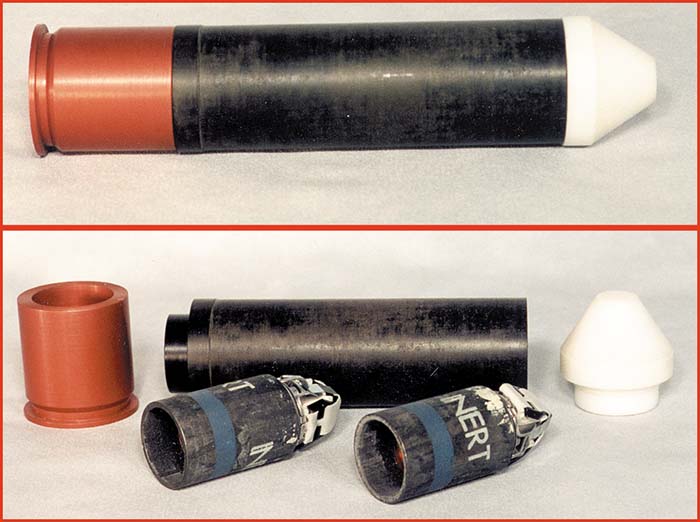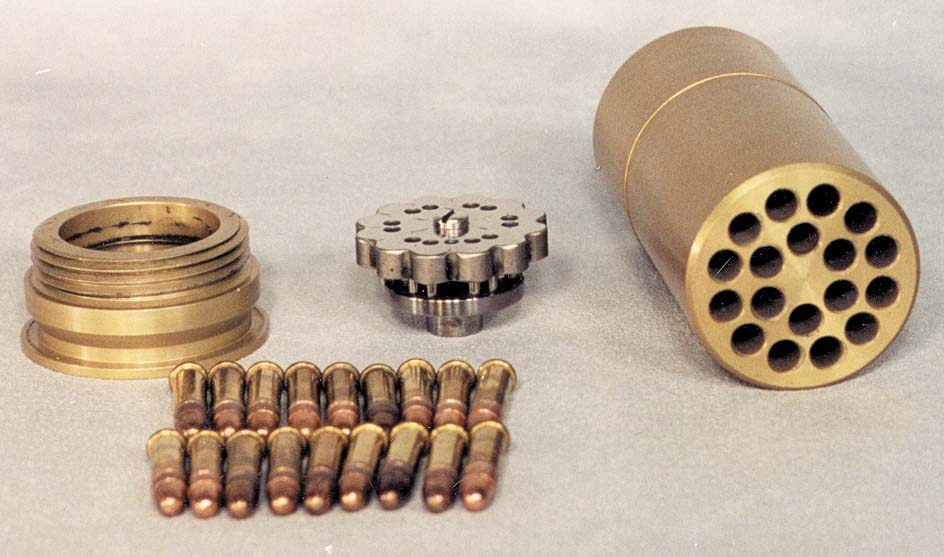.22 Multi-Pellet Cartridge
By Steve Fleischman
Since the beginning of war, throwing objects has been the most popular form of combat. Whether it be rocks or 2000 pound projectiles, hitting your opponent with something has been the goal.
Grenades through history have evolved from light and throw bombs to primitive Civil War potatoes with tail fins, to all forms of Pineapple, egg, and can-shaped objects. All had one thing in common, a good throwing arm was needed.
A variety of rifle-launched objects also evolved with mixed results on accuracy and effect.
After the Korean War there was a need for a new delivery system for antipersonnel munitions, with greater effectiveness and range. The criteria for this new system was lightweight, range out to 400 yards, effective fragmentation, low recoil, and low cost.
Development and manufacture of this weapon system was a multi-faceted effort, of government and private industry. The Vietnam War put additional pressure on the development, which resulted in significant refinement-production techniques, improved quality, and substantial cost reduction.

The shoulder-fired M79 launcher was the first weapon developed to deliver the first production round, the M406 HE. The M203 launcher replaced and paralleled the M79 as an additional weapon system. The M203 was mounted on the M16A1 rifle.
Grenade ammunition up to now was known as HI-LO pressure type with about the same power as a 45 long Colt. A new longer-range offensive type grenade was now being developed that was to be fired from a multitude of weapons being designed. There were a variety of fully automatic belt-fed systems that were developed, such as the M75, XM129, and MK19. All ammunition for these weapons is known as HI pressure type.
Grenade ammunition is basically divided into several categories. First, HI-LO and HI- pressure as defined above. Next we will define as to type, HE, Practice, Pyrotechnic, smoke, riot, shot and “specials”. These specials are just representative samples of a multitude of special purpose cartridges produced experimentally, sometimes field tested and most times just abandoned.

Hi lethality and low cost propagated new thinking and manufacturing methods to produce large numbers of hi velocity fragments from the detonation of 40 mm HE projectiles. The round sphere bomblet as used in the M406 used a rolled, pre -engraved Steel sheet. This sheet was brazed to strengthen it before its re work into a sphere by spinning and drawing. After completion the neck was swaged out and threaded for the fuse and booster. The cylindrical body on the M384 and the M433 was produced by different production means. A pre engraved sheet, by form rolling, produced a plate that kept its strength for deep drawing. The operations are as shown: 1. Blanking disc of pre-engraved Steel. 2 First draw. 3 Trim, face, and bevel. 4 Machine band groove, knurl, and thread for fuse. 5 Install rotating band. 6 Roll in band and cut crimping groove. 7 Finish machine rotating band paint od, prime id.
HI-LO Pressure
HE M406, Round notched sphere bomblet, spin and setback armed point detonating fuse.
HEDP M433, cylindrical steel body, shaped charge, light armor defeating. Fuse is a point detonating with a spitback charge to initate the shaped charge.
HEAP. This He anti-personnel was developed by FN of Belgium using a ball matrix fragmentation and a combo point detonating /time fuse.
HE AIRBURST M397. Special fusing and projectile design produced a new round with the old “bouncing betty” concept. An HE round striking the ground loses half or more of its effectiveness when it detonates. This round rebounds its bomblet to two meters above the ground before it detonates.
PROOF XM387E2. Black heavy projectile, for proofing M79/203.
PRACTICE. Multitude of plastic and metal case and projectile combinations with orange dye markers. Basic issue is the M781, white plastic case, blue plastic nose.
PRACTICE M407A1. This round is an HE simulator, two kinds, and one totally inert with dummy fuse, and the other with a smoke spotting charge.
SHOT. Two styles of XM576, E1 and E2. See reference picture for different shot charge and sabot design. There was even a silenced version developed by AAI.
FLECHETTE. A multitude of different loads and sizes were experimented with.
SMOKE. For all kinds of spotting and signaling. There is ground smoke-M713, red, M714 violet, M716 yellow, and M715 green. Parachute smoke- XM659 red, XM669 violet, XM660 yellow, and XM658 green. Streamer smoke- XM696 yellow, XM697 green, XM699 red, XM698 orange, XM701 violet, and XM700 brown. Canopy smoke- XM682 red, XM681 violet, XM680 white, XM676 yellow, and XM679 green. There is an experimental floating smoke marker that uses a balloon inflated by the burning smoke compound. This system allows it to float on water and or mud and burn for 70 seconds.
PYROTECHNIC. All kinds of signaling cartridges were designed. The main two types were the parachute star XM583 white, XM661 green, XM662 red, and XM695 orange. And the Cluster star XM585 white, Xm663 green, and XM664 red.
RIOT. Many CS gas rounds were developed for non-lethal removal of undesirables and also a variety of plastic and rubber baton rounds.
DBCATA. This silenced round was developed to replace the M203 barrel system. The round was its own barrel, which clipped on to a firing device, which looked very much like the receiver of a 203. The case was rifled and the projectile was pre-engraved. A steel foil “balloon” was folded up and sealed around the propelling charge. When fired the propelling gasses expand the balloon and push out the projectile, with enough force to impart sufficient spin and setback to arm the fuse. The balloon captures all the gases and makes the round silent. DBCATA stands for Disposable-Barrel-Cartridge-Area-Target-Ammunition.
ROCKET ASSISTED. Many types were developed and tested for increased range. Primers and igniters were part of the rocket and came through the back of the case.
ANTENNA CARTRIDGE GR103. This round contained a coil of wire and when fired above the jungle canopy deployed the wire as an antenna. Developed for Navy Seals for burst radio transmission.
MULTI PELLET CARTRIDGE as the military called it. This round was loaded with 18 -22 lr cartridges. A large rifle primer propelled a disc with 18 firing pins which fired all rounds at once. There was no rifling so the bullets tumbled soon after leaving the weapon. This was good or bad depending on what was trying to be achieved. The original military version had a safety wire on its reloadable one. There was also a die-cast throwaway one.
GRAPPLING HOOK PROJECTOR XM688. This round was developed for the Rangers to propel climbing devices higher and farther than they could throw.
M42 MINE PROJECTING. Little is known about this round, except that it propels 2 shaped charge mines of the same type as deployed in other types of ordnance.
FLECHETTE BIOLOGICAL TRANSMITTING. This round has 4 very large flechettes and it is alleged to be some kind of delivery method for what ever you can think of.
HI PRESSURE ROUNDS FOR MK19-XM175.
TARGET PRACTICE M385. Solid Aluminum projectile.
TARGET PRACTICE M918. HE projectile filled with Aluminum slug, inexpensive fuse and spotting charge.
PROOF XM385E3. Heavy Aluminum projectile for proofing weapons.
DUMMY XM922. Gold color, for training.
HEDP M430. Hi velocity shaped charge, for light armored targets up to 2 inches thick.
HE M384. First adopted HE round for the hi velocity series
HE AIRBURST. This experimental round using the M384 body incorporates a self-contained proximity fuse that sends out its own signal and detonates itself at a predetermined distance from the target.
| This article first appeared in Small Arms Review V4N8 (May 2001) |











